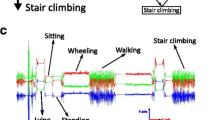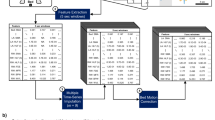Abstract
Alerting investigators with practitioners for patient variability in the mobilization of activity undergone in the identification, recognition, and motor impairments subject to patient treatment enhancement. By adapting recognition models to populations, conventional practices associated with machine learning (ML) can enhance patient activity recognition (AR). Here, the supervised ML classifier is stationary, with the observations fed to the hidden Markov model (HMM). Also, empirically test the efficiency of our model with activities generated by the incomplete vision of ambulatory sessions in spinal cord injury (SCI). Walking, wheeling, lying down, sitting up, standing up, and stair climbing were among the exercises. The maximum classification accuracy using static classifiers alone using within-subject cross-validation was 86.3% (85.5–87.0, 95% confidence). We increased the accuracy to 88.9% by adding an HMM to the classification model (88.2–89.6). Compared to other classifiers, the proposed method outcome of an extra 2.8% showed considerable enhancement for precision classification when employing the classifier under hybridization and stationary characteristics. As a result of this improved activity identification, doctors may be able to choose or fine-tune the best physical or pharmacological therapy to increase patient mobility. Classifiers evaluated and trained in the laboratory utilizing within-subject cross-validation had a 91.6% accuracy rate. Conclusions Despite only a slight increase in activity levels, ambulatory people suffering from SCI enable to grow their ranges of Corticotropin-releasing factor (CRF) throughout the initial stage of inpatient recovery.









Similar content being viewed by others

References
Arif, M., Kattan, A.: Physical activities monitoring using wearable acceleration sensors attached to the body. PLoS ONE 10(7), e0130851 (2015)
Lester, J., Choudhury, T., & Borriello, G.: A practical approach to recognizing physical activities. In: International Conference on Pervasive Computing. Springer, Berlin, Heidelberg, pp. 1–16 (2006)
Brezmes, T., Gorricho, J.L., Cotrina, J.: Activity recognition from accelerometer data on a mobile phone. In: International Work-Conference on Artificial Neural Networks. Springer, Berlin, Heidelberg, pp. 796–799 (2009)
Le Kernec, J., Fioranelli, F., Ding, C., Zhao, H., Sun, L., Hong, H., Lorandel, J., Romain, O.: Radar signal processing for sensing in assisted living: the challenges associated with real-time implementation of emerging algorithms. IEEE Signal Process. Mag. 36(4), 29–41 (2019). https://doi.org/10.1109/MSP.2019.2903715
Chiauzzi, E., Rodarte, C., DasMahapatra, P.: Patient-centered activity monitoring in the self-management of chronic health conditions. BMC Med. 1, 1–6 (2015)
Clarke, A., & Steele, R.: Summarized data to achieve population-wide anonymized wellness measures. In: 2012 Annual International Conference of the IEEE Engineering in Medicine and Biology Society. IEEE, pp. 2158–2161 (2012)
Dobkin, B.H., Xu, X., Batalin, M., Thomas, S., Kaiser, W.: Reliability and validity of bilateral ankle accelerometer algorithms for activity recognition and walking speed after stroke. Stroke 42(8), 2246–2250 (2011)
Al-Qaness, M.A.A., Dahou, A., Abd Elsayed, M., Helmi, A.: Multi-resatt: multilevel residual network with attention for human activity recognition using wearable sensors. IEEE Trans. Ind. Inform. (2022). https://doi.org/10.1109/TII.2022.3165875
Jeannet, P.Y., Aminian, K., Bloetzer, C., Najafi, B., Paraschiv-Ionescu, A.: Continuous monitoring and quantification of multiple parameters of daily physical activity in ambulatory Duchenne muscular dystrophy patients. Eur. J. Paediatr. Neurol. 15(1), 40–47 (2011)
Gaikwad, K.: HMM classifier for human activity recognition. Comput. Sci. Eng. 2(4), 27 (2012)
Kim, E., Helal, S., Cook, D.: Human activity recognition and pattern discovery. IEEE Pervasive Comput. 9(1), 48–53 (2009)
Albert, M.V., Toledo, S., Shapiro, M., Kording, K.: Using mobile phones for activity recognition in Parkinson’s patients. Front. Neurol. 3, 158 (2012)
Saeedi, S., Syed, Z., El-Sheimy, N.: A comparison of feature extraction and selection techniques for activity recognition using low-cost sensors on a smartphone, Vol. 4, pp. 3140–3146 (2012)
Yang, J.: Toward physical activity diary: motion recognition using simple acceleration features with mobile phones. In: Proceedings of the 1st International Workshop on Interactive Multimedia for Consumer Electronics, pp. 1–10 (2009)
Ma, R., Li, S., Zhang, B., Fang, L., Li, Z.: Flexible and generalized real photograph denoising exploiting dual meta attention. IEEE Trans. Cybern (2022). https://doi.org/10.1109/TCYB.2022.3170472
Ma, R., Zhang, B., Zhou, Y., Li, Z., Lei, F.: PID controller-guided attention neural network learning for fast and effective real photographs denoising. IEEE Trans. Neural Netw. Learn. Syst. 33(7), 3010–3023 (2022). https://doi.org/10.1109/TNNLS.2020.3048031
Ma, R., Li, S., Zhang, B., Li, Z.: Towards fast and robust real image denoising with attentive neural network and PID controller. IEEE Trans. Multimedia 24, 2366–2377 (2022). https://doi.org/10.1109/TMM.2021.3079697
Ma, R., Hu, H., Xing, S., Li, Z.: Efficient and fast real-world noisy image denoising by combining pyramid neural network and two-pathway unscented kalman filter. IEEE Trans. Image Process. 29, 3927–3940 (2020). https://doi.org/10.1109/TIP.2020.2965294
Ma, R., Li, S., Zhang, B., Li, Z.: Generative adaptive convolutions for real-world noisy image denoising. Proceed. AAAI Conf. Artif. Intell. 36(2), 1935–1943 (2022). https://doi.org/10.1609/aaai.v36i2.20088
Suutala, J., Pirttikangas, S., Röning, J.: Discriminative temporal smoothing for activity recognition from wearable sensors. In: International Symposium on Ubiquitious Computing Systems. Springer, Berlin, Heidelberg, pp. 182–195 (2007)
Albert, M.V., Kording, K.P., Herrmann, M., Jayaraman, A.: Fall classification by machine learning using mobile phones. PLoS ONE 7(5), e36556 (2012)
Albert, M.V., Toledo, S., Shapiro, M., Kording, K.: Using mobile phones for activity recognition in Parkinson’s patients. Front. Neurol. 3, 158 (2012)
Capela, N.A., Lemaire, E.D., Baddour, N.: Feature selection for wearable smartphone-based human activity recognition with able bodied, elderly, and stroke patients. PLoS ONE 10(4), e0124414 (2015)
Kim, E., Helal, S., Cook, D.: Human activity recognition and pattern discovery. IEEE Pervasive Comput. 9(1), 48–53 (2010)
Ma, R., Li, S., Zhang, B., Hu, H.: Meta PID attention network for flexible and efficient real-world noisy image denoising. IEEE Trans. Image Process. 31, 2053–2066 (2022). https://doi.org/10.1109/TIP.2022.3150294
Wang, H., Zhao, J., Li, J., Tian, L., Tu, P., Cao, T., An, Y., Wang, K., Li, S.: Wearable sensor-based human activity recognition using hybrid deep learning techniques. Secur. Commun. Netw. 2020, 1–2 (2020). https://doi.org/10.1155/2020/2132138
Kooiman, T.J.M., Dontje, M.L., Sprenger, S.R., Krijnen, W.P., van der Schans, C.P., de Groot, M.: Reliability and validity of ten consumer activity trackers. BMC Sports Sci. Med. Rehabil. 7(1), 1–11 (2015)
Liu, P., Nguang, S.K., Partridge, A.: Occupancy inference using pyroelectric infrared sensors through hidden Markov models. IEEE Sens. J. 16(4), 1062–1068 (2015)
Fulk, G.D., Sazonov, E.: Using sensors to measure activity in people with stroke. Top. Stroke Rehabil. 18(6), 746–757 (2011)
Fataniya, A., Modi, H.: Comprehensive analysis of deep learning-based human activity recognition approaches based on accuracy. Int. J. Comput. Digital Syst. 12, 1097–1118 (2022). https://doi.org/10.12785/ijcds/120188
Acknowledgements
The authors extend their appreciation and gratitude to Al-Mustaqbal University College in Iraq for funding this project.
Funding
This work is funded by Al-Mustaqbal University College in Iraq.
Author information
Authors and Affiliations
Contributions
All authors contributed equally to this work.
Corresponding authors
Ethics declarations
Conflict of interest
The authors declare no conflict of interest.
Additional information
Publisher's Note
Springer Nature remains neutral with regard to jurisdictional claims in published maps and institutional affiliations.
Rights and permissions
Springer Nature or its licensor (e.g. a society or other partner) holds exclusive rights to this article under a publishing agreement with the author(s) or other rightsholder(s); author self-archiving of the accepted manuscript version of this article is solely governed by the terms of such publishing agreement and applicable law.
About this article
Cite this article
Kalyani, P., Manasa, Y., Altahan, B.R. et al. Recognition of home activities for incomplete spinal cord injury areas utilizing models of hidden Markov simulation. SIViP 17, 3009–3017 (2023). https://doi.org/10.1007/s11760-023-02521-2
Received:
Revised:
Accepted:
Published:
Issue Date:
DOI: https://doi.org/10.1007/s11760-023-02521-2



